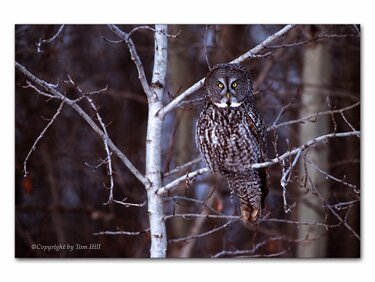

All Images And Text On This Site Are Copyright 1999-2001
by
Thomas D. Hill Jr.
| ABOUT KEIKO |
| WHAT'S NEW |
| THE KEIKO GALLERY |
| EQUIPMENT |
| IMAGE OF THE MONTH |
| ARTICLE OF THE MONTH |

The Great Gray Owl Invasion continues. Since discovering these wonderful creatures had populated the Cold Lake, Alberta area last December, I've spent dozens of hours pursuing them. So this sport isn't the most difficult I've embarked on because Great Grays are very approachable. The simple fact they're readily available to my home makes this situation memorable. A weekend hasn't passed this year where I haven't spent at least some time searching them out and hopefully making a descent image or two. It's quite exciting. IWhen March arrives and the Great Grays make their ways toward the north to nest, I will sorely miss them.
This image is something of an experiment for me. I'm using my brand new 300mm f/2.8 AF-S combined with my TC-14e. I orginally purchased this lens as a big game/mammal tool. I discovered during trips to Jasper NP when shooting Big Horned Sheep and Wapiti Elk that my 500mm f/4 AF-S was too much lens in many situations. Last fall I was working a bull Elk with about 15 other photographers in a fairly confined area. Most of them were using 300mm or 400mm lenses. As a result I had to continueally readjust my shooting position because one or more photographers would get into the way. To compose the image I wanted, I had to shoot from further away and behind the other photographers. Other times, I'd find myself along a road shooting a herd of Big Horned Sheep when they'd approach so close that I'd make a study in "nose hairs". Or, they'd approach just close enough that they'd occupy 95% of the view finder. Clearly it's difficult to make good compositions when you don't have much flexibility. As a result, a lot of my big game/mammal images were beginning to look similar. They were all starting to look like close-up portraits. To improve the variety of my images, I purchased my 300mm f/2.8 AF-S has a tool to create that variety.
Since I just bought the lens I hadn't had any opportunities to explore its potential out in the fields of Jasper NP where I noticed my problem in the first place. The first images I took with this lens were of a Northern Hawk Owl. My 500mm f/4 AF-S instead of the 300mm f/2.8 AF-S was better suited. The bird was just too far and too small with the shorter lens. The next string of wildlife images I took with my 300mm f/2.8 AF-S were of this Great Gray Owl. I had already photographed him with my 500mm f/4 AF-S with excellent results. Since this bird seemed particularly approachable, I decided to explore the flexibility of my new lens by attaching it to my monopod and adding the TC-14e. Right away I knew I could take great images with this combo. The image in the viewfinder was contrasty and sharp. Little did I know how sharp it was.
I shot a half roll of flim of this bird and eventually retired for the morning. Feeling quite fortunate to have had such a cooperative subject as this Great Gray Owl, I promptly forgot about the technical quality of the image through the viewfinder. That is until I got my slides back from the processor. Wow!! It's impossible to demonstrate on the web the true quality of this image, but take my word that it's incredibly sharp. The contrast is awesome and the colors are amazing. The incredible thing to me is this image was taken with a TC-14e attached with the aperture wide open. Imagine how good it could have been with the lens stopped down a bit and without the teleconverter. I've been impressed and that doesn't happen very often.
Another point I'll make about this lens combination's relative light weight and portability. The lens alone is perhaps 50% as large and 2/3's as heavy as my 500mm f/4 AF-S. What does that mean to me as a nature photographer. On long hikes it means my shoulders are less weary. My ability to stay in the field is greatly increased; my opportunities, significantly improved. Also, it performs wonderfully on a monopod. I occasionally use a monopod to improve my flexibility under specific situations. I for sure don't expect tac sharp exposures on a monopod when the shutter speed is less than 1/2 that shutter speed in focal length--ex. 1/150sec with a 300mm lens. But, when I can get this lens on a monopod under the right conditions I have a quick moving, highly reliable piece of kit that's incredibly more comforable to use than my 500mm f/4 AF-S. This lens has opened a whole new world to me.
Cheers,
Tom